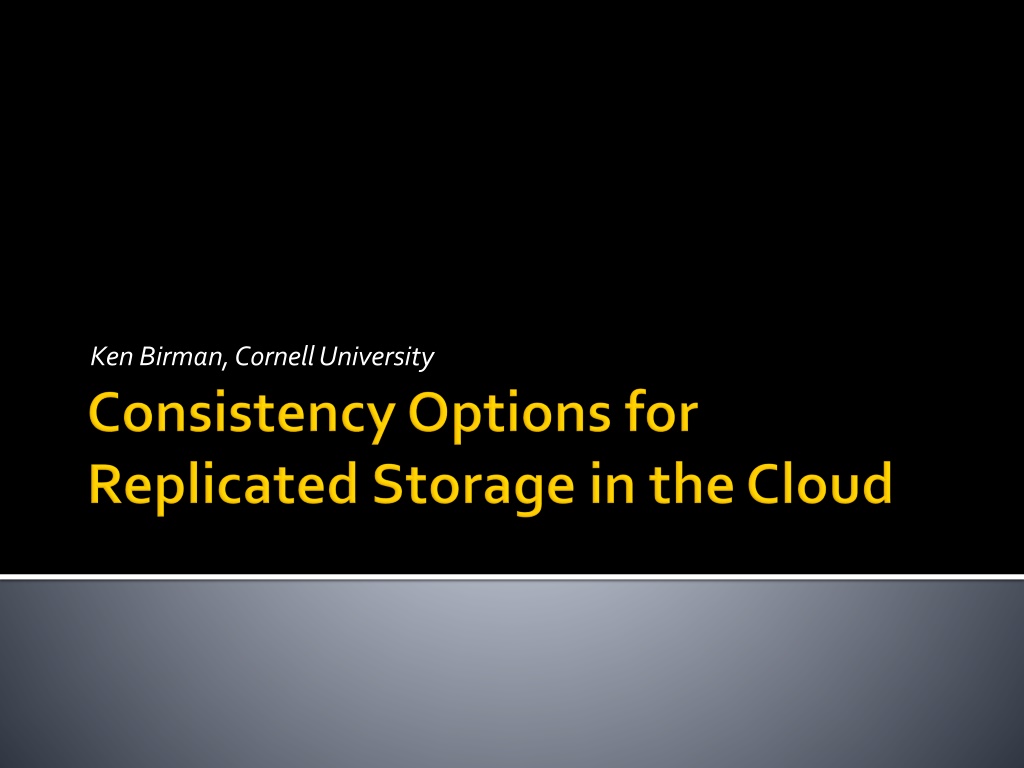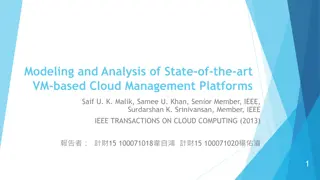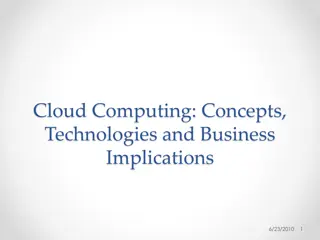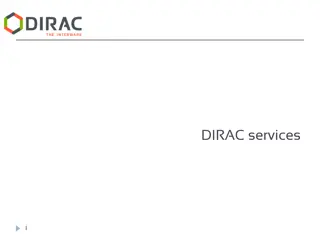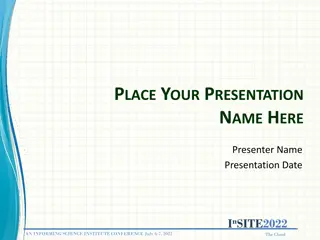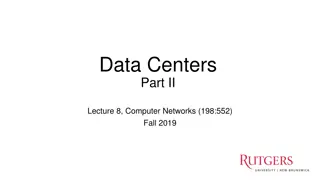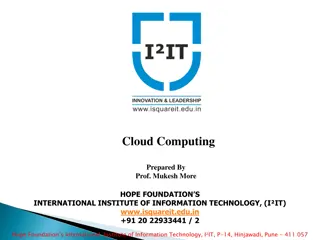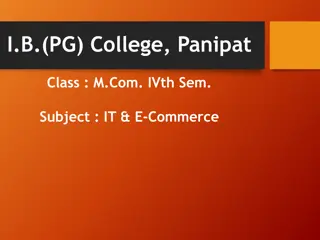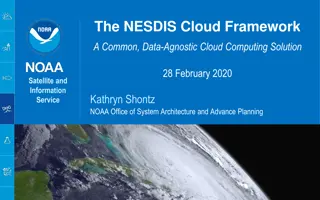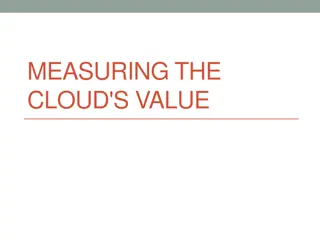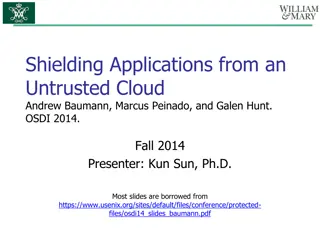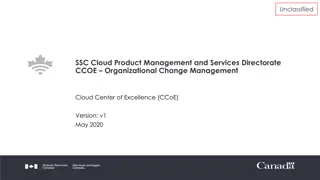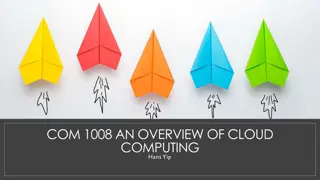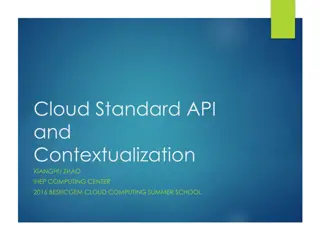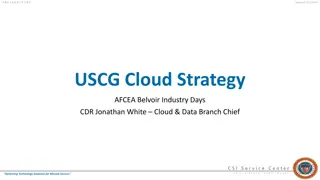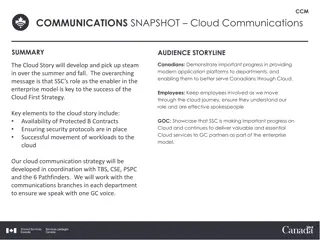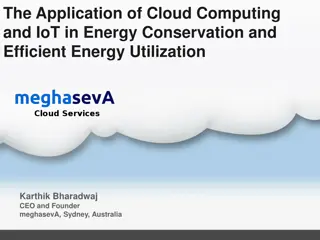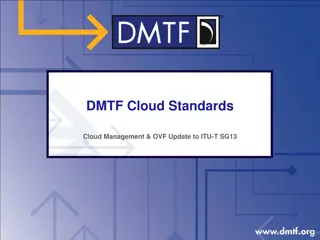Insights into Modern Cloud Computing Trends
Explore key insights shared by industry experts including Ken Birman, Randy Shoup, and Werner Vogels on topics such as consistency, availability, scalability, and synchronization in modern cloud computing. Learn about the challenges and strategies related to maintaining reliability, stability, and scale while embracing inconsistency and decoupling for optimal system performance.
Download Presentation

Please find below an Image/Link to download the presentation.
The content on the website is provided AS IS for your information and personal use only. It may not be sold, licensed, or shared on other websites without obtaining consent from the author. Download presentation by click this link. If you encounter any issues during the download, it is possible that the publisher has removed the file from their server.
E N D
Presentation Transcript
In a 2000 PODC keynote, Brewer speculated that Consistency is in tension with Availability and Partition Tolerance P is often taken as Performance today Assumption: can t get scalability and speed without abandoning consistency CAP rules in modern cloud computing 4/8/2010 Birman: Microsoft Cloud Futures 2010 2
http://tbn0.google.com/images?q=tbn:h3bkxvCwXi3MLM:http://image4.360doc.com/DownloadImg/2009/4/9/2459_3077871_1.jpghttp://tbn0.google.com/images?q=tbn:h3bkxvCwXi3MLM:http://image4.360doc.com/DownloadImg/2009/4/9/2459_3077871_1.jpg As described by Randy Shoup at LADIS 2008 Thou shalt 1. Partition 1. Partition Everything 2. Use 2. Use Asynchrony Asynchrony Everywhere 3. Automate 3. Automate Everything Everything 4. 4. Remember Remember: : Everything 5. 5. Embrace Embrace Inconsistency Inconsistency Everything Everywhere Everything Fails Fails 4/8/2010 Birman: Microsoft Cloud Futures 2010 3
Werner Vogels is CTO at Amazon.com His first act? He banned reliable multicast*! Amazon was troubled by platform instability Vogels decreed: all communication via SOAP/TCP This was slower but Stability and Scale dominate Reliability (And Reliability is a consistency property!) * Amazon was (and remains) a heavy pub-sub user 4/8/2010 Birman: Microsoft Cloud Futures 2010 4
http://tbn0.google.com/images?q=tbn:Pig8hhEVvPOuSM:http://www.mvdirona.com/jrh/work/JamesHamilton.jpghttp://tbn0.google.com/images?q=tbn:Pig8hhEVvPOuSM:http://www.mvdirona.com/jrh/work/JamesHamilton.jpg Key to scalability is decoupling, loosest possible synchronization Any synchronized mechanism is a risk His approach: create a committee Anyone who wants to deploy a highly consistent mechanism needs committee approval http://tbn1.google.com/images?q=tbn:6MtljZVfkzOKKM:http://weblogs.newsday.com/news/local/longisland/politics/blog/judges.jpg . They don t meet very often 4/8/2010 Birman: Microsoft Cloud Futures 2010 5
A consistent distributed system will often have many components, but users observe behavior indistinguishable from that of a single-component reference system http://tbn2.google.com/images?q=tbn:frnioDXHT-jnNM:http://image.guardian.co.uk/sys-images/Arts/Arts_/site_furniture/2008/05/08/Bond460x276.jpg Image: Photo of my Omega Seamaster 2531.80 on 1:18 scale Aston Martin model Reference Model Implementation 4/8/2010 Birman: Microsoft Cloud Futures 2010 6
Transactions that update replicated data Atomic broadcast or other forms of reliable multicast protocols Distributed 2-phase locking mechanisms 4/8/2010 Birman: Microsoft Cloud Futures 2010 7
A=A+1 A=3 B=7 B = B-A Non-replicated reference execution p p q q r r s s t t Time: 0 10 20 30 40 50 60 70 Time: 0 10 20 30 40 50 60 70 Synchronous execution Virtually synchronous execution Synchronous runs: indistinguishable from non-replicated object that saw the same updates (like Paxos) Virtually synchronous runs are indistinguishable from synchronous runs 4/8/2010 Birman: Microsoft Cloud Futures 2010 8
12000 10000 messages /s They see consistency as a root cause for meltdowns, thrashing 8000 6000 4000 2000 0 250 400 550 700 850 time (s) What ties consistency to such issues? They claim: Systems that put guarantees first don t scale For example, any reliability property forces a system to retransmit lost messages, use acks, etc Most networks drop messages if overloaded So struggling to guarantee consistency will increase load just when we prefer to shed load 4/8/2010 Birman: Microsoft Cloud Futures 2010 9
My rent check bounced? That can t be right! Inconsistency causes bugs Clients would never be able to trust servers a free-for-all Jason Fane Properties 1150.00 Sept 2009 Tommy Tenant Tommy Tenant Weak or best effort consistency? Strong security guarantees demand consistency Would you trust a medical electronic-health records system or a bank that used weak consistency for better scalability? 4/8/2010 Birman: Microsoft Cloud Futures 2010 10
To reintroduce consistency we need A scalable model Should this be the Paxos model? The old Isis one? A high-performance implementation Can handle massive replication for individual objects Massive numbers of objects Won t melt down under stress Not prone to oscillatory instabilities or resource exhaustion problems 4/8/2010 Birman: Microsoft Cloud Futures 2010 11
Im reincarnating group communication! Basic idea: Imagine the distributed system as a world of live objects somewhat like files They float in the network and hold data when idle Programs import them as needed at runtime The data is replicated but every local copy is accurate Updates, locking via distributed multicast; reads are purely local; failure detection is automatic & trustworthy 4/8/2010 Birman: Microsoft Cloud Futures 2010 12
A library highly asynchronous Group g = new Group( /amazon/something ); g.register(UPDATE, myUpdtHandler); g.Send(UPDATE, John Smith , new_salary); public void myUpdtHandler(string empName, double salary) { . } 4/8/2010 Birman: Microsoft Cloud Futures 2010 13
Just ask all the members to do their share of work: Replies = g.query(ALL, LOOKUP, Name=*Smith ); Replies.doCallback(myReplyHndlr); public void lookup(string who) { double myAnswer = mySearch(who, myRank, nMembers); reply(myAnswer); } public void myReplyHndlr(double[] whatTheyFound) { } 4/8/2010 Birman: Microsoft Cloud Futures 2010 14
Group g = new Group(/amazon/something); g.register(LOOKUP, myLookup); Replies = g.Query(ALL, LOOKUP, Name=*Smith ); public void myLookup(string who) { double myAnswer = mySearch(who, myRank, nMembers); reply(myAnswer); } Replies.doCallback(myReplyHndlr); public void myReplyHndlr(double[] fnd) { foreach(double d in fnd) avg += d; } 4/8/2010 Birman: Microsoft Cloud Futures 2010 15
The group is just an object. User doesn t experience sockets multicast . marshalling preprocessors protocols As much as possible, they just provide arguments as if this was a kind of RPC, but no preprocessor Sometimes they provide a list of types and Isis does a callback Groups have replicas handlers a current view in which each member has a rank 4/8/2010 Birman: Microsoft Cloud Futures 2010 16
Cant we just use Paxos? In recent work (collaboration with MSR SV) we ve merged the models. Our model subsumes both This new model is more flexible: Paxos is really used only for locking. Isis can be used for locking, but can also replicate data at very high speeds, with dynamic membership, and support other functionality. Isis2 will be much faster than Paxos for most group replication purposes (1000x or more) [Building a Dynamic Reliable Service. Ken Birman, Dahlia Malkhi and Robbert van Renesse. Available as a 2009 technical report, in submission to PODC10 and ACM Computing Surveys...] 4/8/2010 Birman: Microsoft Cloud Futures 2010 17
End user codes in C# or any of the other ~40 .NET languages, or uses Isis2 as a library via remoting on Linux platforms from C++, Java, etc Really fast pub/sub Really fast replication BFT, DB xtns DHTs, Overlays Virtual Synchrony Multicast (sender or total order, group views, ) Safe (Paxos) Multicast Gossip Objects Basic Isis2 Process Groups 4/8/2010 Birman: Microsoft Cloud Futures 2010 18
Isis2 has a built in security architecture Can authenticate join requests And can encrypt every multicast using dynamically created keys that are secrets guarded by group members and inaccessible even to Isis2 itself The system also uses AES to compress messages if they get large 4/8/2010 Birman: Microsoft Cloud Futures 2010 19
To build Isis2 I need to find ways to achieve consistency and yet also achieve Superior performance and scalability Tremendous ease of use Stability even under attack 4/8/2010 Birman: Microsoft Cloud Futures 2010 20
It comes down to better resource management because ultimately, this is what limits scalability The most important example: IPMC is an obvious choice for updating replicas But IPMC was the root cause of the oscillation shown earlier (see fear of consistency ) 4/8/2010 Birman: Microsoft Cloud Futures 2010 21
Traditional IPMC systems can overload the router, melt down Issue is that routers have a small space for active IPMC addresses In [Vigfusson, et al 09] we show how to use optimization to manage the IPMC space In effect, merges similar groups while respecting limits on the routers and switches Melts down at ~100 groups 4/8/2010 Birman: Microsoft Cloud Futures 2010 22
End user codes in C# or any of the other ~40 .NET languages, or uses Isis2 as a library via remoting on Linux platforms from C++, Java, etc Really fast pub/sub Really fast replication BFT, DB xtns DHTs, Overlays Virtual Synchrony Multicast (sender or total order, group views, ) Safe (Paxos) Multicast Gossip Objects Basic Isis2 Process Groups Managed IPMC abstraction (controls the actual IPMC addresses used, does flow control, can map IPMC to UDP if it wishes to do so) 4/8/2010 Birman: Microsoft Cloud Futures 2010 23
Algorithm by Vigfusson, Tock [HotNets 09, LADIS 2008, Submission to Eurosys 10] Uses a k-means clustering algorithm Generalized problem is NP complete But heuristic works well in practice 4/8/2010 Birman: Microsoft Cloud Futures 2010 24
o Assign IPMC and unicast addresses s.t. % receiver filtering (hard) Min. network traffic # IPMC addresses (hard) M (1) Prefers sender load over receiver load Intuitive control knobs as part of the policy 4/8/2010 Birman: Microsoft Cloud Futures 2010 25
Topics in `user- interest space FGIF BEER GROUP (1,1,1,1,1,0,1,0,1,0,1,1) (0,1,1,1,1,1,1,0,0,1,1,1) FREE FOOD 4/8/2010 Birman: Microsoft Cloud Futures 2010 26
Topics in `user- interest space 224.1.2.4 224.1.2.5 224.1.2.3 4/8/2010 Birman: Microsoft Cloud Futures 2010 27
Topics in `user- interest space Sending cost: MAX Filtering cost: 4/8/2010 Birman: Microsoft Cloud Futures 2010 28
Unicast Topics in `user- interest space Sending cost: MAX Filtering cost: 4/8/2010 Birman: Microsoft Cloud Futures 2010 29
Unicast Unicast Topics in `user- interest space 224.1.2.4 224.1.2.5 224.1.2.3 4/8/2010 Birman: Microsoft Cloud Futures 2010 30
multicast Heuristic Procs L-IPMC Procs L-IPMC Processes use logical IPMC addresses Dr. Multicast transparently maps these to true IPMC addresses or 1:1 UDP sends 4/8/2010 Birman: Microsoft Cloud Futures 2010 31
We looked at various group scenarios Most of the traffic is carried by <20% of groups For IBM Websphere, Dr. Multicast achieves 18x reduction in physical IPMC addresses [Dr. Multicast: Rx for Data Center Communication Scalability. Ymir Vigfusson, Hussam Abu-Libdeh, Mahesh Balakrishnan, Ken Birman, and Yoav Tock. LADIS 2008. November 2008. Full paper submitted to Eurosys 10.] 4/8/2010 Birman: Microsoft Cloud Futures 2010 32
For small groups, reliable multicast protocols directly ack/nack the sender For large ones, use QSM technique: tokens circulate within a tree of rings Acks travel around the rings and aggregate over members they visit (efficient token encodes data) This scales well even with many groups Isis2 uses this mode for |groups| > 25 members, with each ring containing ~25 nodes [Quicksilver Scalable Multicast (QSM). Krzys Ostrowski, Ken Birman, and Danny Dolev. Network Computing and Applications (NCA 08), July 08. Boston.] 4/8/2010 Birman: Microsoft Cloud Futures 2010 33
We also need flow control to prevent bursts of multicast from overrunning receivers AJIL protocol imposes limits on IPMC rate AJIL monitors aggregated multicast rate Uses optimization to apportion bandwidth If limit exceeded, user perceives a slower multicast channel [Ajil: Distributed Rate-limiting for Multicast Networks. Hussam Abu- Libdeh, Ymir Vigfusson, Ken Birman, and Mahesh Balakrishnan (Microsoft Research, Silicon Valley). Cornell University TR. Dec 08.] 4/8/2010 Birman: Microsoft Cloud Futures 2010 34
AJIL reacts rapidly to load surges, stays close to targets (and we re improving it steadily) Makes it possible to eliminate almost all IPMC message loss within the datacenter! 4/8/2010 Birman: Microsoft Cloud Futures 2010 35
Dramatically more scalable yet always consistent, fault-tolerant, trustworthy group communication and data replication Extremely high speed: updates map to IPMC To make this work Manage IPMC address space, do flow control Aggregate acknowledgements Leverage gossip mechanisms 4/8/2010 Birman: Microsoft Cloud Futures 2010 36
Were starting to believe that all IPMC loss may be avoidable (in data centers) Imagine fixing IPMC so that the protocol was simply reliable. Never drops messages. Well, very rarely. Now and then, like once a month, some node drops an IPMC but this is so rare that it triggers a reboot! I could toss out more than ten pages of code related to multicast packet loss! 4/8/2010 Birman: Microsoft Cloud Futures 2010 37
Isis2is under development code is mostly written and I m debugging it now Goal is to run this system on 500 to 500,000 node systems, with millions of object groups Success won t be easy, but would give us a faster replication option that also has strong consistency and security guarantees! 4/8/2010 Birman: Microsoft Cloud Futures 2010 38
